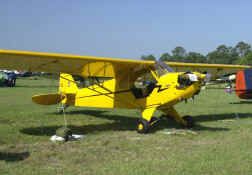LAKELAND – Fly-ins attract a wide a variety of people, from those who love to see the static displays and marvel at the aerobatic performances to others who enjoy the educational aspect of these events. This year’s Sun ‘n Fun Fly-In was no different. Sure, the new aerobatic performances like Bobby Younkin’s Learjet act and favorites like Jimmy Franklin’s Jet Waco are a big part of the events. However, these are not all of the benefits to be enjoyed. Forums and educational activities area an important part of this fly-in and this year’s were especially enlightening in many ways. A case in point was the ongoing series of forums on the proposed and ever-evolving Sport Pilot certificate.
Sport Pilot’s Slow Progress
Another Fly-In season begins with Sun ‘n Fun’s festivities and another year has passed on the procedural mumbo jumbo of the Sport Pilot proposal. At least that’s some peoples’ opinions on one of the greatest pieces of aviation certification in history.
You may remember that, two years ago, the EAA announced their work toward getting this new certificate passed through the FAA’s regulatory system and into the awaiting flying public’s hands. At last year’s Sun ‘n Fun event, EAA headquarters staff and FAA officials presented various forums on the new proposed certificate and the status of its procedural moves through the FAA’s Washington office. A few months after that, at the EAA’s AirVenture Oshkosh convention, Secretary of Transportation Norman Mineta and FAA Administrator Jane Garvey both addressed a standing-room-only crowd and informed us all that the Notice Of Proposed Rulemaking (NPRM) was about to go into effect, and was actually expected to be released by the Office of Management and Budget (OMB) during the show.
Well, that didn’t happen and then came the horrific events of September 11, which rattled our minds and crippled the aviation industry for some time. So, now that things are “somewhat” returning to normal, the FAA has continued its work on making Sport Pilot a reality.
FAA Adds Technology To The Mix
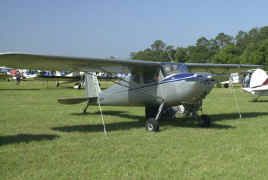 Here we are a few months later and Sport Pilot NPRM has finally been issued in a rather unique and historic way. The comment period includes an online “Town Hall Meeting,” as it’s been dubbed by the FAA. For the first time in agency history, a virtual public comment period has been implemented to receive the expected great amount of feedback from the flying public. The marvels of technology now allow us to input online our critique and /or support of the proposal without the need of having to write those laborious snail mail letters. The FAA is very proud of this latest leap in service and the agency representatives attending the Sun ‘n Fun Sport Pilot forums were more than happy to boast about it, and with good reason. The “kindler, gentler” FAA apparently is really willing to help move the process along.
Here we are a few months later and Sport Pilot NPRM has finally been issued in a rather unique and historic way. The comment period includes an online “Town Hall Meeting,” as it’s been dubbed by the FAA. For the first time in agency history, a virtual public comment period has been implemented to receive the expected great amount of feedback from the flying public. The marvels of technology now allow us to input online our critique and /or support of the proposal without the need of having to write those laborious snail mail letters. The FAA is very proud of this latest leap in service and the agency representatives attending the Sun ‘n Fun Sport Pilot forums were more than happy to boast about it, and with good reason. The “kindler, gentler” FAA apparently is really willing to help move the process along.
“We’re Here To Help” is a slogan that draws scoffs from the flying public, yet it is advertised by the agency as a promise. Well, Sun ‘n Fun seemed to be the perfect venue for the FAA to prove its case. Two of the agency’s main players in the Sport Pilot proposal were on site to discuss their role and status of the certificate’s progress.
Sue Gardner, FAA Sport Pilot Project Manager, and Mike Gallagher, Manager of the FAA Small Aircraft Directorate in Wichita, joined EAA officials in presenting various forums discussing the status of the long-awaited certificate. Similar to last year’s presentations at Sun ‘n Fun, these forums were the perfect venue for attendees to hear the latest news, voice their opinions and ask questions about the proposal. However, there was one piece of news lacking from last year’s presentations … the latest NPRM.
Gardner and Gallagher discussed the new online comment venue in detail. They stressed the importance of providing input online and making any suggestions on how to improve the current proposal. The FAA’s message was welcomed by those in attendance, as several people took time to support, criticize and also offer their own suggestions to the proposal. As expected, many questions arose about certification and training issues, including those surrounding the so-called “fat ultralights.”
Determining Just Who Does Qualify
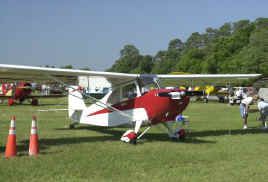 There has been much speculation about what aircraft would and would not qualify under this new certificate. While the standards have been set and a list of applicable aircraft determined, FAA and industry are working together on the final touches of the introduction to market. In the meantime, light aircraft manufacturers are getting ready to enter this new market full of sales opportunities. This anticipation was evident at Sun ‘n Fun where several companies boldly placed signs outside their exhibits announcing that their aircraft was “Sport Pilot compliant” or something to that effect.
There has been much speculation about what aircraft would and would not qualify under this new certificate. While the standards have been set and a list of applicable aircraft determined, FAA and industry are working together on the final touches of the introduction to market. In the meantime, light aircraft manufacturers are getting ready to enter this new market full of sales opportunities. This anticipation was evident at Sun ‘n Fun where several companies boldly placed signs outside their exhibits announcing that their aircraft was “Sport Pilot compliant” or something to that effect.
So, what are the specifications for these new aircraft? EAA’s Sport Pilot web site, contains a list of 271 Sport Pilot-eligible models. The current NPRM defines a light-sport aircraft as having:
A maximum of two occupants.
A maximum take-off weight of 1,232 pounds (560 kg.) or less.
A 39-knot stall speed in the landing configuration. (44 knots without the use of lift-enhancing devices.)
A 115-knot maximum operating speed.
A single engine.
Fixed landing gear, or repositionable gear for a seaplane.
Of course, the list may change, along with the associated aircraft, but we’ll cross that bridge if we ever get to it.
To Insure Or Not Insure…That Is The Question
Certifying sport pilot aircraft is one thing, insuring them is another. While aircraft manufacturers ready to sell their newly “certified” aircraft, the thought of insurance coverage seems to be laid to the sideline. AVweb spoke with some industry officials and the jury was still out on what coverage may be available to Sport Aircraft operators.
Realistically, insurers expect to cover the factory-built aircraft without much hesitation, as long as they already have a proven track record. New companies and novel designs would be examined and determinations would be made accordingly. When dealing with homebuilt-transitioned aircraft, the story waters seem to be a bit muddy, and these insurance professionals admit that most aircraft would be evaluated on a case-by-case basis.
Be warned, most coverage will be liability only, as insurers have to determine if they can cover the hull of a particular aircraft just as owners will need to evaluate if a particular premium is worth paying to protect their investment. Organizations like the EAA offer insurance partnerships and several industry sources believe that these programs will continue through Sport Pilot.
Sitting Down With EAA
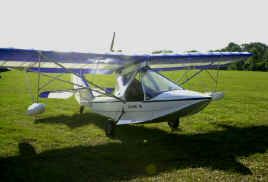 To help us piece the Sport Pilot puzzle together, EAA’s Executive Vice-President Bob Warner sat down with AVweb. Warner offered the organization’s perspective on the proposal and its progress.
To help us piece the Sport Pilot puzzle together, EAA’s Executive Vice-President Bob Warner sat down with AVweb. Warner offered the organization’s perspective on the proposal and its progress.
When asked if the Sport Pilot proposal was affected much by the events of 9/11, Warner admitted to some delay, but quickly pointed out the FAA’s move for Sport Pilot’s quick return to priority status. He was more than happy to identify things that were moving along nicely prior to the attacks, and after the attacks. FAA Sport Pilot officials continued to work on the proposal just a few weeks after the horrific events in New York City, Washington D.C. and rural Pennsylvania. While the FAA’s main offices in Washington, D.C. were shut down for awhile, the agency’s Sport Pilot team continued its work. However, the D.C. building’s closing eventually affected the progress of the proposal, as key decision makers were not able to concentrate on Sport Pilot, and obviously had more pressing matters at hand.
Warner is very pleased that the NPRM has now been released and now awaits the end of the comment period and subsequent FAA examination of all the public feedback received. In the meantime, he encourages all of those interested in Sport Pilot to read the NPRM and offer their own commentary in the online forum. “This is their golden opportunity to make a difference,” said Warner. “The FAA is really taking the time to read each and every comment received and everyone’s opinion counts, ” he added.
Continuing with the topic of the effects of 9/11, we asked Warner what effects the attacks had on the Sport Pilot proposal with regard to public and government sentiment. Warner believes that the tragic events of September have actually made the process somewhat easier, in an unfortunate sort of way. The FAA is now more open to working with the so-called “fat ultralights,” a term often used to refer to small aircraft now being operated as “ultralights” although they don’t meet the FAA definition, usually because they carry passengers or exceed the weight limits. Warner believes that the federal government is more apt to rid the industry of these illegal operations, especially since the non-flying public has deemed certain aircraft groups as “dangerous.” “Legitimacy is the key,” Warner said. “The illegals need to either shape up or ship out,” he added.
Warner clarified that he doesn’t want to eliminate or segment those groups of pilots from the industry, but rather to ask them to conform to legal operating standards. He added that having those pilots and aircraft join the Sport Pilot ranks will provide them the “power of the federal government” behind them in addition to creating a collective voice with which to speak.
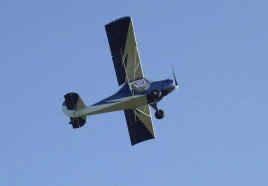 EAA is excited about the method used by the FAA to develop type certification for Light Sport Aircraft. The FAA is essentially asking the industry to come up with its own airworthiness standards by consensus, rather then having the agency develop and impose the standards. Manufacturers have already met once in Oshkosh, and planned to meet again soon to start on the nuts and bolts of writing the standards. Warner is enthusiastic about this new process and its emphasis on involving the manufacturers from the start.
EAA is excited about the method used by the FAA to develop type certification for Light Sport Aircraft. The FAA is essentially asking the industry to come up with its own airworthiness standards by consensus, rather then having the agency develop and impose the standards. Manufacturers have already met once in Oshkosh, and planned to meet again soon to start on the nuts and bolts of writing the standards. Warner is enthusiastic about this new process and its emphasis on involving the manufacturers from the start.
This is a fairly new approach to aircraft certification. Previously, aircraft manufacturers had been required to build to type certification standards of one level or another and obtain a production certificate assuring that each aircraft would be produced the same as the other. EAA’s Warner is excited about this new process and expects this to integrate the manufacturers’ input into a comprehensive design plan.
So, while progress is slow, it has begun to pick up renewed momentum. Warner admits that the process hasn’t been easy, but is confident that things are well underway. Barring any further complications, he sees a realistic possibility of having a final rule out by the end of 2002. Time will tell … .
Complete Coverage Index
- 1. Special Report: Sun ‘N Fun 2002
The opening of Sun ‘N Fun 2002, although punctuated by tragedy, was buoyant and upbeat. Glorious weather and capacity crowds in the display areas may combine to make this among the best shows in years. Avweb’s Dave Higdon is in Lakeland and filed this report.
- 2. Update Report: Sun ‘N Fun 2002
It must be something in the water, because the giddy feeling just won’t subside at Sun ‘N Fun 2002. There are looping Lears, skydiving Skyhawks, morphing models, space shots … and a volume of visitors just having a great time. As more than one patron stated, “You gotta go.” Avweb’s Away Team did go and filed this report. By Glenn Pew.
- 3. Closing Report: Sun ‘N Fun 2002
The weatherman called a close to Sun ‘N Fun as patrons launched to beat approaching weather. It was a good show for patrons and exhibitors alike (and a good showing by patrons and exhibitors alike). As he prepared to head for home, the skies returned to blue and Avweb’s Dave Higdon sat back and filed this report.
- 4. Sun ‘N Fun 2002 Sport Pilot Forum
Not everyone was basking in the Florida sunshine all week long at Sun ‘N Fun 2002. Some folks were attending a variety of educational forums offered on a multitude of topics. One of the most popular was the Sport Pilot certificate forum, featuring guest appearances by the FAA’s Sue Gardner and Mike Gallagher. AVweb’s Arturo Weiss also was in attendance and filed this report.
- 5. Sun ‘N Fun 2002 Image Gallery
Photography by Bob Kaputa.
- 6. Sun ‘N Fun 2002 Image Gallery II
Photography by Bob Kaputa.

































